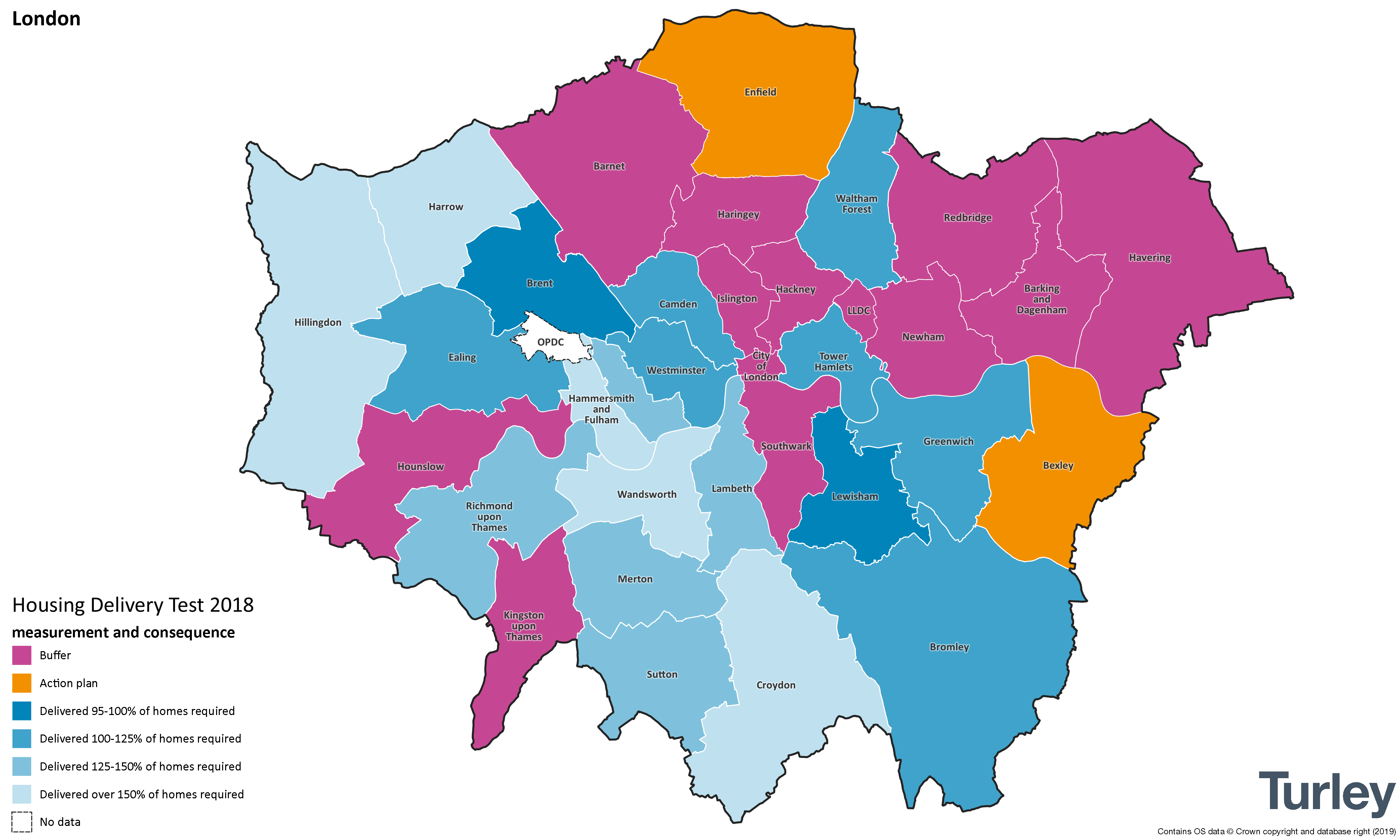Comment
The NPPF will bite in London
London planning authorities must now take seriously the implications of the NPPF (February 2019) and the need to deliver many more homes at much higher densities.
If not taken seriously, they risk planning applications that they have refused being overturned by Inspectors at appeal, as a result of the NPPF presumption in favour of sustainable development. See our commentary here.
Housing Delivery Test
Last week the Government published the results of the Housing Delivery Test. This identified that the following London authorities all had delivery rates of less than 85%, and now face the consequences of an additional 20% to their five-year housing land supply requirements: Barking and Dagenham, Barnet, City of London, Hackney, Haringey, Havering, Hounslow, Islington, Kingston-upon-Thames, London Legacy Development Corporation, Newham, Redbridge and Southwark.
Bexley and Enfield have delivered less than 95% (but 85% or more) of housing requirements and now have to produce an action plan.The action plans must explain why they have not delivered the required amount of housing and what they intend to do about it. The above mentioned authorities that delivered less than 85% of housing will also have to produce action plans.
No London authorities have suffered the penalty of having their own local plan policies rendered out-of-date because of sub-25% delivery rates (‘substantial’ under-delivery). However, the substantial under-delivery threshold increases to 45% this coming November, meaning that authorities that have delivered less than this are treading on thin ice and might face the most severe sanction; Barking and Dagenham, City of London and Redbridge all fall into this category.

Tilted balance
The presumption in favour of sustainable development (known as the ‘tilted balance’) now applies when policies most important for determining the application are out of date. The tilted balance previously applied (under the 2012 NPPF) only when policies relating to the supply of housing (for example settlement boundary policies) were out of date.
The tilted balance is engaged when an authority has substantially under-delivered and/or where it cannot demonstrate a five-year housing land supply. The previously mentioned London authorities that now suffer the additional 20% buffer because of poor housing delivery rates will likely find it a further challenge to demonstrate that they can deliver a five year supply of housing, plus buffer. Even those local authorities with good past housing delivery rates will find it difficult to demonstrate a five-year housing supply because of the higher targets from the New London Plan that they must deliver against. Furthermore it is likely that targets will increase further because, once adopted, the New London Plan is expected to undergo an immediate review to ensure its housing targets are in line with the NPPF’s standard methodology for calculating targets.The consequence of this will be that London authorities’ supply will worsen.
Once the tilted balance is engaged, those London authorities cannot rely fully on their development plan policies*. The starting point for housing applications, in accordance with NPPF paragraph 11, is to grant planning permission unless any adverse impacts of doing so would significantly and demonstrably outweigh the benefits, when assessed against the policies in the NPPF taken as a whole.
We envisage that London authorities will initially not acknowledge the tilted balance and its implications because from a political perspective they would not want a departure from their own policies. One cannot, however, ignore national planning policy and therefore we suspect that there will be an increased number of housing schemes in London for the Planning Inspectorate to determine, whilst engaging the tilted balance as a consequence of the Housing Delivery Test.
Overall, a large amount of London authorities could already be in titled balance territory where they cannot rely fully on their development plan policies, as a result of the higher targets they have to deliver against, and because of the 20% buffer which is applied to the authorities which have delivered poorly over the past three years. They should now, and will be required to, start granting permission for housing schemes more readily in order to address the identified under delivery. The NPPF will indeed bite in London, more than it ever has before.
For more information on the NPPF in London please contact Craig Slack.
*Unless the site is a habitats site and/or designated as Sites of Special Scientific Interest; designated as Green Belt, Local Green Space; has irreplaceable habitats; designated heritage assets (and other heritage assets of archaeological interest); or areas at risk of flooding or coastal change.
25 February 2019